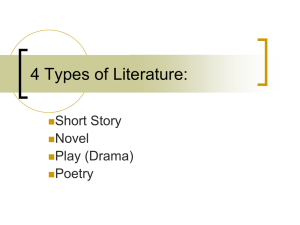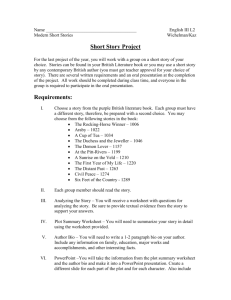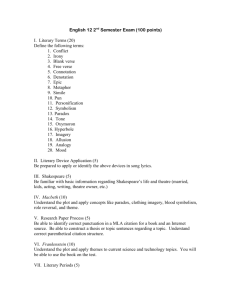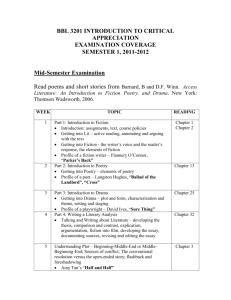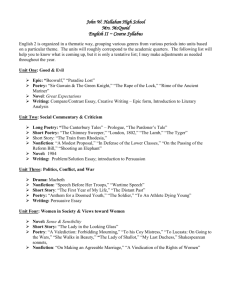9th Grade English Language Arts Course Syllabus
advertisement
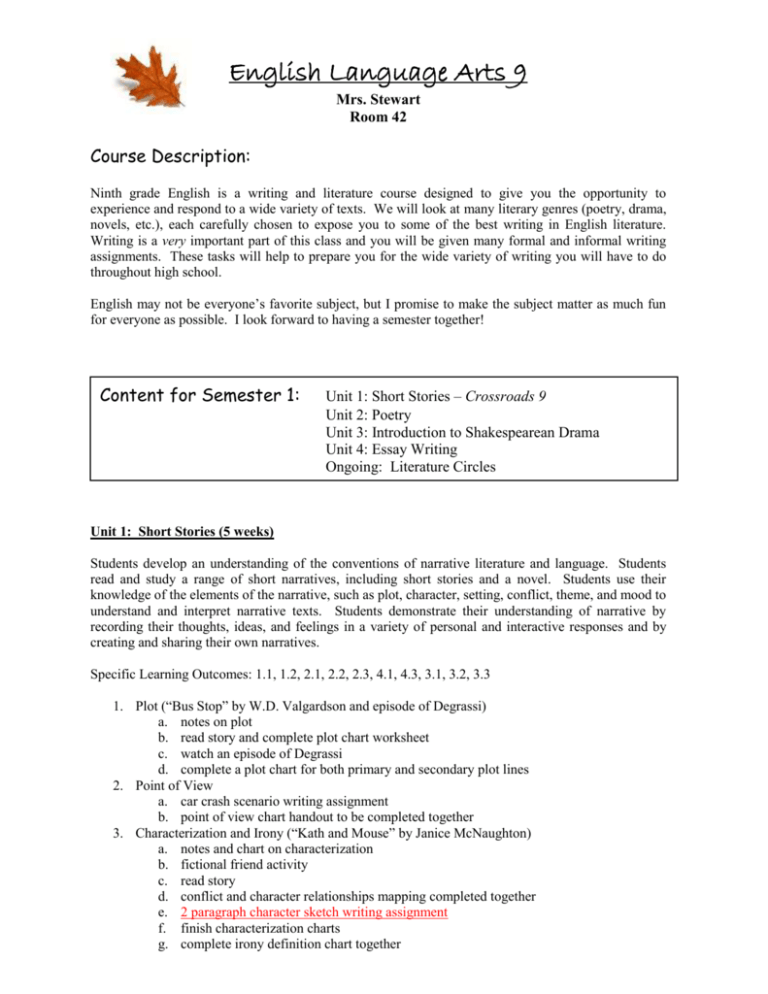
English Language Arts 9 Mrs. Stewart Room 42 Course Description: Ninth grade English is a writing and literature course designed to give you the opportunity to experience and respond to a wide variety of texts. We will look at many literary genres (poetry, drama, novels, etc.), each carefully chosen to expose you to some of the best writing in English literature. Writing is a very important part of this class and you will be given many formal and informal writing assignments. These tasks will help to prepare you for the wide variety of writing you will have to do throughout high school. English may not be everyone’s favorite subject, but I promise to make the subject matter as much fun for everyone as possible. I look forward to having a semester together! Content for Semester 1: Unit 1: Short Stories – Crossroads 9 Unit 2: Poetry Unit 3: Introduction to Shakespearean Drama Unit 4: Essay Writing Ongoing: Literature Circles Unit 1: Short Stories (5 weeks) Students develop an understanding of the conventions of narrative literature and language. Students read and study a range of short narratives, including short stories and a novel. Students use their knowledge of the elements of the narrative, such as plot, character, setting, conflict, theme, and mood to understand and interpret narrative texts. Students demonstrate their understanding of narrative by recording their thoughts, ideas, and feelings in a variety of personal and interactive responses and by creating and sharing their own narratives. Specific Learning Outcomes: 1.1, 1.2, 2.1, 2.2, 2.3, 4.1, 4.3, 3.1, 3.2, 3.3 1. Plot (“Bus Stop” by W.D. Valgardson and episode of Degrassi) a. notes on plot b. read story and complete plot chart worksheet c. watch an episode of Degrassi d. complete a plot chart for both primary and secondary plot lines 2. Point of View a. car crash scenario writing assignment b. point of view chart handout to be completed together 3. Characterization and Irony (“Kath and Mouse” by Janice McNaughton) a. notes and chart on characterization b. fictional friend activity c. read story d. conflict and character relationships mapping completed together e. 2 paragraph character sketch writing assignment f. finish characterization charts g. complete irony definition chart together 4. Internal monologue and review quiz (“Lamb to the Slaughter” by Roald Dahl) a. read story b. complete plot chart together c. Quiz d. Internal Monologue assignment 5. Characterization (“Coffee, Snacks, Worms) 6. Setting, Mood and Foreshadowing (“Most Dangerous Game” by Richard Connell) a. notes on setting, juxtaposition, conflict, and foreshadowing b. vocabulary words worksheet c. read story d. close reading questions worksheet e. notes on conflict 7. Paragraph writing, Imagery (“The Tell-Tale Heart” by E.A. Poe) a. vocabulary questions worksheet b. read story c. notes on atmosphere and imagery d. worksheet 8. Conflict, Symbolism, Theme (“Borders” by Thomas King) a. read story b. complete features chart together c. complete character map together d. plot timeline chart e. notes on symbolism and theme f. timeline, critical reading chart, reader response paragraphs g. 4 Ws newspaper article 9. Test review worksheet 10. Test – Terminology and analysis of “On the Sidewalk Bleeding” by Evan Hunter Unit 2: Poetry (3 weeks) Students read and study a variety of poetic forms and learn to identify different types of poems. Students apply appropriate strategies to read, understand, and interpret poetic texts. They learn to understand the value of auditory devices, figurative language, and form in creating powerful poetry. During this unit, students demonstrate their understanding of poetry by writing Response Journals, explications of poems, and original poetry; by participating in class activities; by presenting poems orally; by adapting a poem to a media form; and creating a Poetry Anthology. Specific Learning Outcomes: 1.1, 1.2, 2.1, 2.2, 2.3, 3.1, 3.2, 4.1, 4.2 Unit 3: Drama (3 weeks) Students apply the skills learned in the earlier units to the study of drama. Students identify, analyse, and interpret the elements of dramatic structure, character, characterization, theme, setting, and stylistic features of drama, including movement and voice. Students come to an understanding of the importance of the context (social, cultural, political) in which a literary work was created. Students demonstrate their understanding by recording their thoughts, ideas, and feelings about the characters, conflicts, and themes of the work in a variety of personal and interactive responses; by writing a literary exposition; by rehearsing and performing a dramatic scene; and by creating and sharing a media work. Specific Learning Outcomes: 1.1, 1.2, 2.1, 2.2, 4.1, 4.2, 5.1, 5.2 Unit 4: Essay Writing (3 weeks) During this unit students will learn and apply several essential writing skills including formulating a thesis, identifying audience and purpose and organizing an argument. Students will also improve their ability to read and think critically through the examination of several non-fiction essays. In this way, they will familiarize themselves with the basic building blocks of effective non-fiction from sentence variety to well-constructed paragraphs to properly ordered points. They will then put these techniques into practice by writing their own pieces of non-fiction, and with practice, they will become more efficient and effective writers and communicators. Specific Learning Outcomes: 1.1, 1.2, 2.1, 2.2, 2.3, 3.1, 3.2, 4.1, 4.2, 5.1, 5.2 Unit 5: Literature Circles (On-going) Students will individually select and read a novel approved by the teacher. Students will respond to elements of their novel in their journals. They will also develop a letter to the author, or write a review of the novel. Students will then deliver an oral presentation to the class pertaining to their novel. Specific Learning Outcomes: 1.1, 1.2, 3.3, 4.2, 4.3, 4.4, 5.1, 5.2 Teaching / Learning Strategies Because my students learn in a variety of ways, I will attempt to accommodate various learning styles in my teaching. Students will be given opportunities for brainstorming, experimenting, discussing, debating, researching, role playing, and creative arts integration projects. Some strategies I will use also include: concept-mapping, simulations, peer learning groups and cooperative learning. Throughout the short-story and poetry study the use of Response Journals will be important, helping students to identify and develop their ideas for writing, discussion, performances, and media products. My students will work independently on many assigned tasks but will also have frequent opportunities to work with partners and in groups. Assessment Participation/Classroom Assignments Formal Writing Assignments Literature Circles Tests Midterm/Exam 25% 25% 10% 15% 25% I will include many traditional assessment strategies, including tests, quizzes, and examinations. Student voice will also play an important role in this course through projects, presentations, skills demonstration, role playing, and work samples. The personal communication methods I will include will be instructional questions and answers, conferences, journals/learning logs, and classroom discussion. My assessment and evaluation tools will include checklists, rubrics, portfolios, and anecdotal comments.
